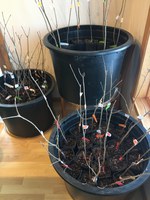Dakota Gardener: Tree Planting in Winter? I Love Science
(Click an image below to view a high-resolution image that can be downloaded)
By Joe Zeleznik, Forester
NDSU Extension
On Super Bowl Sunday, I planted my first trees for 2021.
The high temperature was minus 11. Clearly, they weren’t planted outside.
I used tall pots for the 24 green ash seedlings and 24 bur oak seedlings. They’re both native species and can withstand our cold winters, along with droughts and occasional floods. We don’t have a greenhouse at home, so the trees are in our dining room. For now.
I’m trying to see what happens to the annual tree rings when the trees break out of dormancy early. Do the rings develop normally? If not, can I describe or measure the different growth?
This is dining room science, but it has nothing to do with dinner selection or human nutrition.
In my studies on tree rings, I’ve observed several thousand rings from hundreds of trees throughout North Dakota and western Minnesota. The rings show which years had great growing conditions and which years were dry. We can tell when a tree was wounded and sometimes we can see flooding in the rings.
Can we tell which years had an abnormally early spring? That’s what I’m trying to figure out.
The annual rings for 1910, 1958 and 2012 in many local bur oak trees show something weird. I know, that’s not a very scientific description. Nevertheless, the rings for these years are clearly different than those from other years.
I remember that spring came early in 2012. The maple tree on our boulevard in Fargo was flowering in January. Yes, January. Temperatures were in the low 50s for at least three days that month. That maple tree, and many others in the area, didn’t survive.
But the green ash and the bur oak trees did survive. And the bur oaks had a weird ring in 2012. Apparently, the spring of 1910 also came early, leaving its mark on the bur oak trees. I’ve seen similarly weird rings in green ash trees in 1947 and 1986 as well, at least in western North Dakota.
And that brings us back to the experiment. Can we force an early spring on these tree seedlings? Yes, we can. We did it last year as well, growing more than 100 seedlings in our greenhouse - I mean in our dining room. Seedlings were planted in early February, early March and early April and they all broke bud and grew normally. Did that early spring result in weird growth in the rings?
I don’t know yet. The experiment isn’t finished.
A downside to this project is that the seedlings have to be killed to look at the rings. To look at the rings of large, standing trees, we extract cores from them. The cores go across the rings, showing the tree’s response each year. Coring makes a small wound in the stem, but the trees recover within a year or two. Too bad I can’t do that with these tiny seedlings.
I love this project because it demonstrates the scientific method, where we take our observations and come up with explanations. The explanations become hypotheses that we then test in a controlled environment. And then we adjust our experiments and re-test, and test again.
I’ll keep doing that for as long as my wife lets me keep trees in the dining room. Thanks, dear!
For more information about gardening, contact your local NDSU Extension agent. Find the Extension office for your county at https://www.ag.ndsu.edu/extension/directory/counties.
NDSU Agriculture Communication - Feb. 9, 2021
Source: Joe Zeleznik, 701-231-8143, joseph.zeleznik@ndsu.edu
Editor: Ellen Crawford, 701-231-5391, ellen.crawford@ndsu.edu




